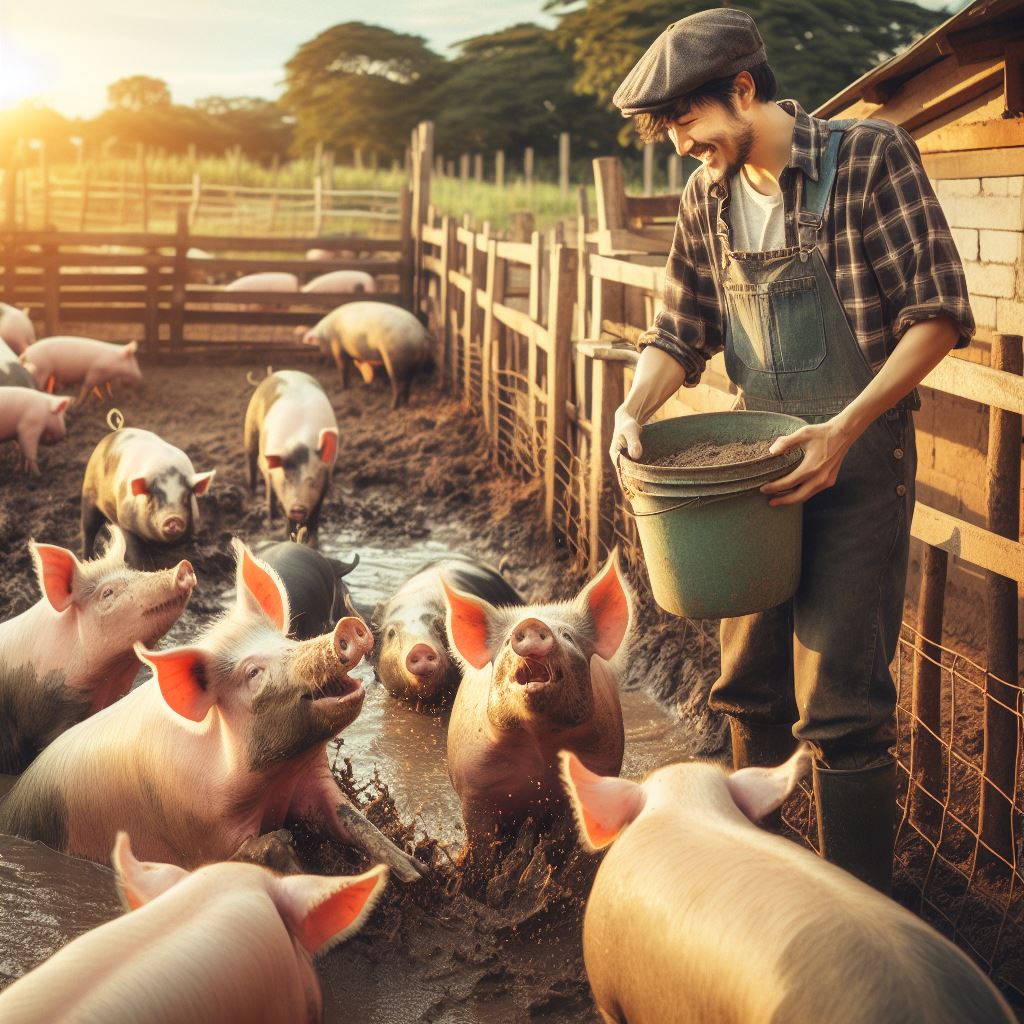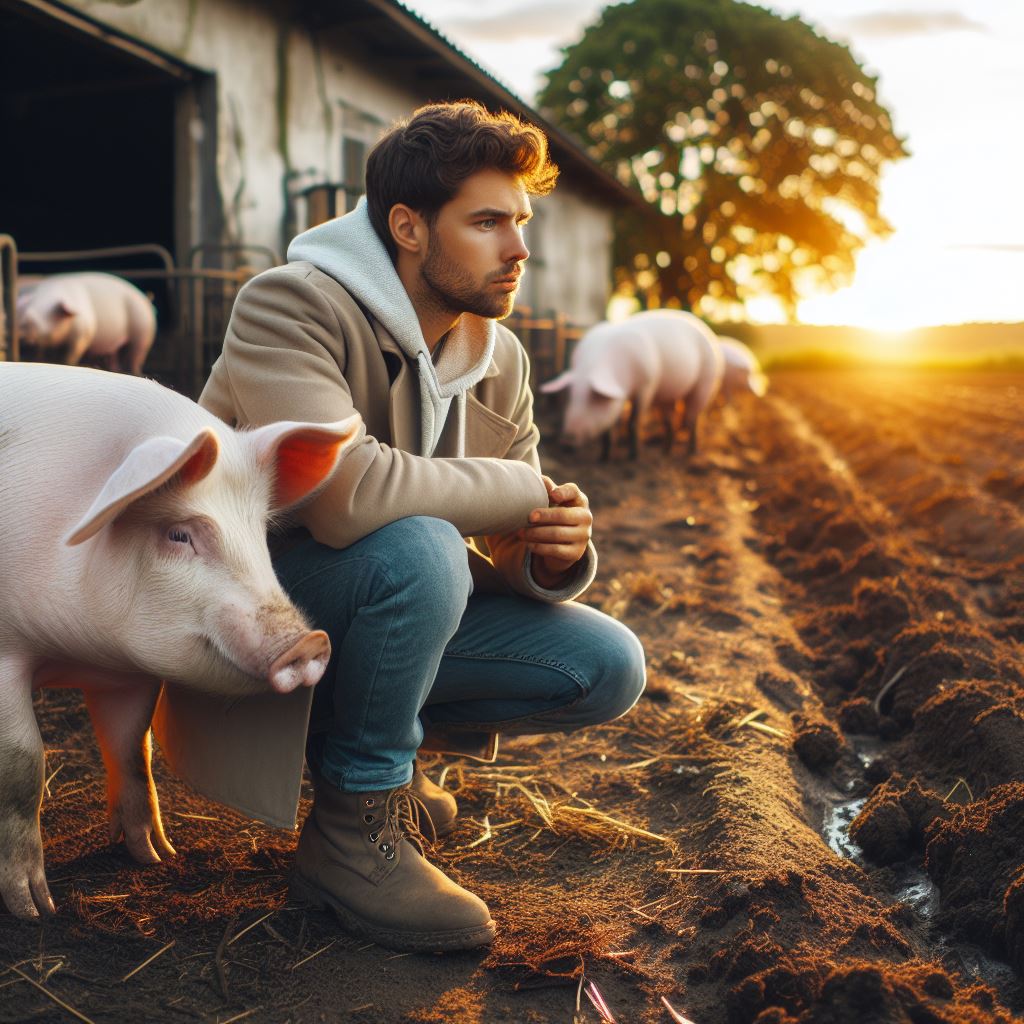Introduction
Pig fertility is an essential aspect of successful breeding. When it comes to pig farming, the ability of pigs to reproduce plays a vital role in determining the profitability and sustainability of the operation.
Implementing best practices is crucial in ensuring high fertility rates among pigs.
These practices include providing proper nutrition, appropriate mating management, maintaining good hygiene, and regular health check-ups.
In this blog post, we will explore various aspects related to pig fertility and breeding best practices. We will discuss the reproductive cycle of pigs and the factors that can affect fertility.
Additionally, we will delve into the importance of proper nutrition, stress reduction, and the optimal age for breeding.
Furthermore, we will highlight the significance of genetic selection in improving pig fertility.
Breeding programs aimed at selecting superior genetics can significantly enhance fertility rates and overall herd productivity.
By following the best practices discussed in this blog post, pig farmers can improve breeding outcomes, increase litter sizes, and enhance overall reproductive efficiency.
These practices not only benefit the farmer but also contribute to the sustainable growth of the pig farming industry as a whole.
So, if you are interested in maximizing pig fertility and achieving successful breeding, keep reading to discover the most effective strategies and best practices.
Understanding Pig Fertility
Definition and Factors Affecting pig fertility
Pig fertility refers to the ability of female pigs to conceive and give birth to healthy piglets. Several factors can influence pig fertility, including:
- Genetics: Breeding pigs with good genetics can increase fertility rates and improve overall reproductive performance.
- Breeding method: Artificial insemination can enhance fertility rates by ensuring optimal timing and quality of semen.
- Hormonal balance: Imbalances in hormones, such as progesterone and estrogen, can affect the estrous cycle and lead to fertility problems.
- Reproductive tract health: Conditions like uterine infections or abnormalities can hamper fertility and conception rates.
- Sow and boar management: Proper care, including cleanliness, regular health checks, and stress reduction, can positively impact fertility.
Age and weight considerations in breeding
Age and weight are crucial factors to consider when breeding pigs for optimal fertility rates:
- Sow age: Young sows should reach sexual maturity, which typically occurs around 7-9 months, before breeding to maximize fertility.
- Boar age: Boars should be mature enough to produce high-quality semen, usually around 8-10 months old.
- Weight requirements: Sows should have appropriate body condition and reach a target weight, usually between 260-300 pounds, before breeding.
- Underweight or overweight sows: Poor body condition can lead to reduced fertility rates, so maintaining proper weight is essential.
Importance of proper nutrition for enhancing fertility
Proper nutrition plays a critical role in enhancing pig fertility:
- Balanced diet: Providing sows with a well-balanced diet ensures they receive the necessary nutrients for reproductive functions.
- Adequate energy levels: Sows need sufficient energy to support heat cycles, embryo development, and lactation.
- Nutrient supplementation: Certain vitamins, minerals, and amino acids, such as folic acid and zinc, promote optimal reproductive health.
- Body condition scoring: Regular body condition assessment helps monitor nutritional status and make necessary dietary adjustments.
Effects of stress and environmental conditions on fertility
Stress and environmental conditions can significantly impact pig fertility:
- Heat stress: High temperatures can disrupt heat cycles, decrease conception rates, and reduce litter sizes.
- Noise and disturbances: Loud noises and constant disturbances can cause stress and negatively affect reproductive performance.
- Housing conditions: Proper ventilation, temperature control, and space availability are crucial for maintaining optimal fertility.
- Social stress: Introducing unfamiliar animals or disrupting social hierarchies can lead to stress-related fertility issues.
In essence, understanding pig fertility involves considering various factors such as genetics, breeding methods, hormonal balance, and reproductive tract health.
Transform Your Agribusiness
Unlock your farm's potential with expert advice tailored to your needs. Get actionable steps that drive real results.
Get StartedAdditionally, age, weight, nutrition, and stress levels significantly influence fertility rates.
By implementing best practices in pig breeding, farmers can enhance fertility outcomes and ensure successful reproduction in their herds.
Selecting Breeding Stock
Choosing healthy and genetically superior boars and sows
- Health and genetics are essential factors to consider when selecting breeding stock.
- Look for boars and sows with good overall health, free from any diseases or genetic abnormalities.
- Consider the breed’s inherent fertility traits and choose animals with high fertility rates.
- Evaluate the animals’ conformation, body condition, and overall reproductive soundness.
Considerations for genetic diversity and avoiding inbreeding
- Genetic diversity is crucial in maintaining the overall health and productivity of the pig population.
- Avoid inbreeding by selecting breeding stock from different bloodlines and maintaining a diverse gene pool.
- Inbreeding can lead to decreased fertility, birth defects, and overall reduced productivity in pig herds.
- Regularly assess the genetic history and pedigree of the potential breeding stock.
Evaluating the reproductive history and performance of potential breeding stock
- The reproductive history of boars and sows is a significant indicator of their fertility and breeding potential.
- Assess the number of piglets born per litter, the survival rate of the piglets, and the overall reproductive efficiency.
- Evaluate the weaning weights of previous litters to determine the genetic potential for growth and productivity.
- Utilize performance records and data to select breeding stock with proven reproductive success.
Importance of conducting health screenings and disease prevention measures
- Conducting health screenings is essential to ensure that the selected breeding stock is free from diseases.
- Regularly test for common swine diseases such as Porcine Reproductive and Respiratory Syndrome (PRRS) and Swine Influenza.
- Implement proper biosecurity measures to minimize the risk of introducing diseases into the herd.
- Maintain a vaccination program to protect the breeding stock and future litters from common pig diseases.
By following these best practices in selecting breeding stock, pig farmers can improve the overall fertility and reproductive performance of their herds.
Choosing healthy and genetically superior animals ensures that desirable traits are passed on to future generations.
Moreover, considering genetic diversity and avoiding inbreeding helps prevent the negative consequences associated with limited gene pools.
Evaluating the reproductive history and performance of potential breeding stock provides valuable insights into their breeding potential.
Finally, conducting health screenings and implementing disease prevention measures is crucial for maintaining a healthy and productive pig population.
Preparing for Breeding
Determining the right timing for breeding
- Monitor the sow’s heat cycle to identify the optimal time for breeding.
- Use heat detection methods such as back pressure testing or boar exposure.
- Consult with a veterinarian to assess the sow’s reproductive readiness.
Managing the estrous cycle in sows
1. Implement proper estrus synchronization techniques to improve breeding efficiency.
2. Utilize hormonal treatments like prostaglandins or gonadotropin-releasing hormone (GnRH).
3. Regularly observe sows for signs of estrus and record the duration of each cycle.
Proper housing and environmental considerations
- Provide comfortable and clean housing facilities to reduce stress on breeding animals.
- Ensure sufficient space for sows to move and exhibit natural behaviors.
- Maintain appropriate temperature and ventilation levels in the breeding area.
Ensuring adequate nutrition and body condition of breeding stock
- Develop a well-balanced diet to meet the nutritional requirements of breeding animals.
- Monitor body condition score (BCS) and adjust feeding regimes accordingly.
- Provide access to fresh water at all times and consider supplementation if necessary.
Veterinary care and vaccinations for breeding animals
- Establish a comprehensive health program in consultation with a veterinarian.
- Ensure timely vaccinations to protect breeding animals from common diseases.
- Regularly schedule veterinary examinations to identify and address any reproductive issues.
Read: Biosecurity in Livestock Farms: Key Practices

Breeding Techniques and Practices
Introduction to natural breeding and artificial insemination (AI)
Natural breeding is the traditional method of allowing animals to mate naturally.
Artificial insemination (AI) involves inserting sperm into the female reproductive tract without natural mating.
Benefits and challenges of each breeding method
Natural breeding allows for genetic selection through natural competition, but it can be unpredictable.
AI provides controlled mating, disease control, and genetic advancement, but it requires skilled technicians.
Step-by-step guidelines for natural breeding
- Properly introduce the male and female pigs by placing them in a familiar environment.
- Observe the female for signs of estrus, such as swollen vulva and increased activity.
- Allow the male to mount the female when she is in standing heat.
- Ensure successful mating by confirming penetration and ejaculation.
- Separate the pair after mating to prevent re-mating, and monitor the female for conception.
Step-by-step guidelines for AI, including proper handling and storage of semen
- Collect the semen from the boar using a collection device.
- Evaluate the semen quality through visual inspection and laboratory testing.
- Dilute the semen with an appropriate extender to increase the number of insemination doses.
- Load the semen into a specialized AI gun and insert it into the female’s reproductive tract.
- Properly store the remaining semen in liquid nitrogen for future use.
By following these breeding techniques and practices, pig farmers can optimize pig fertility and breeding success.
Read: Biosecurity in Livestock Farms: Key Practices
Monitoring and Maximizing the Conception Rate
Techniques for heat detection and monitoring fertility
By effectively monitoring and maximizing conception rates, pig farmers can significantly improve their breeding outcomes.
Techniques for heat detection and monitoring fertility play a crucial role in identifying sows in heat and optimizing breeding success.
Implementing tools like heat detection patches and pedometers can enhance accuracy in heat detection, minimizing missed opportunities.
Importance of proper mating management to improve conception rates
Furthermore, ensuring proper mating management is essential for improving conception rates.
Maintaining appropriate boar-to-sow ratios prevents overwork and stress on both parties, enhancing successful breeding.
Additionally, maintaining optimal body condition and nutrition for boars and sows further supports their fertility.
Understanding and addressing infertility issues in sows and boars
Addressing infertility issues in sows and boars is crucial for successful pig breeding.
Conducting regular reproductive examinations and semen analysis helps identify potential problems early on.
Veterinary intervention can then address issues such as uterine infections, cysts, or abnormal reproductive anatomy.
Showcase Your Farming Business
Publish your professional farming services profile on our blog for a one-time fee of $200 and reach a dedicated audience of farmers and agribusiness owners.
Publish Your ProfileGenetics also play a significant role in addressing infertility concerns.
Evaluating the genetic background of breeding animals and implementing appropriate culling strategies can help eliminate animals with hereditary fertility problems, improving overall breeding outcomes.
Strategies for optimizing litter size and reducing stillborn or mummified piglets
To optimize litter size and reduce stillborn or mummified piglets, proper management throughout gestation and farrowing is essential.
Ensuring adequate nutrition and body condition of sows during gestation directly impacts litter size.
Ultrasound or palpation can help monitor fetal numbers and identify any potential abnormalities, allowing for timely interventions.
Establishing a strict farrowing management plan is crucial to promote piglet survival.
Practicing good hygiene, providing proper nesting materials, and offering prompt assistance during farrowing can significantly reduce the risk of stillbirths or mummified piglets.
Generally, by employing effective heat detection techniques, implementing proper mating management, addressing infertility issues, and optimizing farrowing practices, pig farmers can maximize conception rates, improve litter size, and reduce the incidence of stillborn or mummified piglets.
These practices contribute to overall success and profitability in pig breeding operations.
Read: Biosecurity in Livestock Farms: Key Practices
Post-Breeding Care
Achieving successful pig fertility goes beyond the breeding process.
It is crucial to provide appropriate care and attention to pregnant sows and their offspring to ensure optimal piglet survival rates and overall productivity.
Monitoring pregnant sows and providing appropriate nutrition and care
- Regularly monitor pregnant sows to ensure their well-being and detect any potential issues early on.
- Provide a balanced and nutritious diet to support the sow’s health and the development of her piglets.
- Ensure access to clean water at all times, as dehydration can have detrimental effects on both the sow and her litter.
- Monitor the sow’s body condition and adjust her diet accordingly to prevent excessive weight gain or loss.
- Provide adequate housing and space for the pregnant sows, allowing them to move comfortably and express natural behaviors.
- Create a stress-free environment by minimizing disturbances and providing proper ventilation and temperature control.
- Implement a vaccination program to protect the pregnant sows from common diseases and strengthen their immune systems.
- Regularly inspect and clean the sow’s living area to maintain good hygiene and minimize the risk of infections.
Pregnancy confirmation techniques and monitoring fetal development
- Use reliable pregnancy confirmation techniques, such as ultrasound or blood tests, to ensure accurate breeding results.
- Monitor the sow’s weight gain during pregnancy to assess her overall health and the development of the fetuses.
- Keep records of important dates and milestones to determine the expected farrowing date and plan accordingly.
- Consult with a veterinarian to perform regular check-ups and ultrasounds to monitor fetal development and detect any abnormalities.
Preparing farrowing facilities and managing the farrowing process
- Ensure farrowing facilities are clean, well-maintained, and equipped with appropriate heating and ventilation systems.
- Provide comfortable and safe farrowing pens with sufficient bedding to promote sow and piglet well-being.
- Prepare the necessary equipment and supplies for assisting with farrowing, such as clean towels, disinfectants, and heating lamps.
- Train staff members on proper farrowing management techniques, including assisting with difficult births and recognizing signs of distress.
- Monitor the farrowing process closely, offering assistance if needed, while respecting the sow’s natural instincts.
Post-farrowing care and maximizing piglet survival rates
- Ensure the immediate removal of any stillborn or weak piglets to prevent them from compromising the health of the litter.
- Provide colostrum, the first milk, to the piglets within the first few hours of birth to boost their immune systems.
- Monitor each piglet’s weight gain and overall condition to ensure they are thriving.
- Implement strategies to prevent piglet crushing, such as using farrowing crates or providing safe spaces for smaller piglets.
- Keep the farrowing area clean, dry, and warm to minimize the risk of infections and maintain optimal piglet health.
- Provide a balanced and easily digestible creep feed to piglets starting around three weeks of age to encourage early solid feed intake.
- Regularly assess the piglets’ growth and adjust their diet accordingly to promote healthy development and market weight.
- Consider cross-fostering piglets to even out litter sizes and ensure each piglet has access to enough milk and resources.
- Work closely with a veterinarian to establish a health management program, including vaccinations and preventive treatments.
- Monitor piglet mortality rates and evaluate and improve management practices to minimize losses and maximize survival rates.
By diligently following these post-breeding care practices, pig farmers can enhance pig fertility outcomes and ensure the well-being and productivity of their sows and piglets.
Read: Swine Flu: Protecting Your Pig Herds
You Might Also Like: Climate-Smart Cattle Farming
See Related Content: Winter Care for Sheep and Goats
Conclusion
In this blog post, we discussed several key points regarding pig fertility and breeding best practices
The blog post on Pig Fertility: Breeding Best Practices emphasizes key strategies for optimizing pig reproduction.
It underscores the importance of maintaining proper body condition in sows through balanced nutrition.
Timely detection of estrus and accurate heat detection are highlighted as crucial factors in successful breeding.
The post advocates for a well-managed mating process, with attention to boar selection and proper mating techniques.
Additionally, it emphasizes the significance of maintaining a stress-free environment for pigs to enhance fertility.
The blog promotes a holistic approach, combining nutrition, monitoring, and management practices to improve pig fertility and ensure successful breeding outcomes.
It is essential to emphasize the importance of implementing these best practices to ensure successful pig fertility.
Implementing best practices for pig fertility is crucial for sustainable and profitable swine production.
Optimal reproductive performance ensures a consistent and efficient breeding cycle, leading to higher piglet production.
Proper management of nutrition, health, and environmental conditions directly impacts sow fertility and litter size.
Timely heat detection, artificial insemination techniques, and genetic selection contribute to improved reproductive outcomes.
Efficient pig fertility not only enhances overall herd productivity but also minimizes production costs. Investing in these best practices ensures a robust and economically viable pig farming operation, emphasizing the vital role of reproductive management in achieving long-term success.
By applying the knowledge gained from this post, readers can significantly improve their breeding practices, resulting in better pig fertility outcomes.




